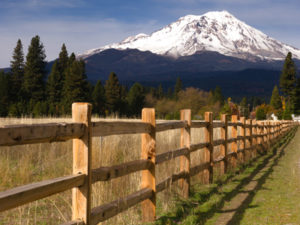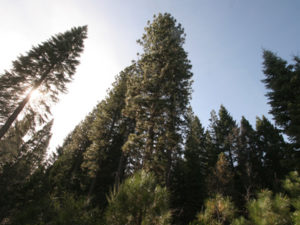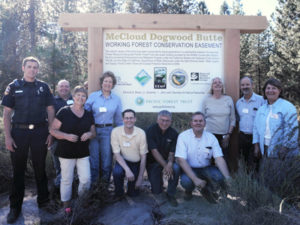
Summer 2016 ForestLife
Realizing the Vision for Conservation Across Boundaries
PUBLIC-PRIVATE COLLABORATION BENEFITS WILDLIFE, WATERSHEDS, AND WORKING LANDS IN THE MOUNT SHASTA HEADWATERS CONSERVATION AREA
 It can take a week to hike all the way around majestic Mount Shasta, crossing a rugged landscape that blends the Shasta-Trinity National Forest with commercial timberland and family ranches. From its vistas, you can easily see that regardless of ownership, it is one awesome place.
It can take a week to hike all the way around majestic Mount Shasta, crossing a rugged landscape that blends the Shasta-Trinity National Forest with commercial timberland and family ranches. From its vistas, you can easily see that regardless of ownership, it is one awesome place.
The massive, 14,179-foot, glacier-clad volcano forms the hub of an eco-regional wheel in northern California. Standing tall where the Cascade Mountains meet the Modoc Plateau, Klamath Mountains, and Great Valley, Mount Shasta and its surrounding landscape are home to world-class biodiversity, headwaters of major waterways, and highly productive forests.
Because of its great topographical variety, plentiful springs, and a confluence of volcanic, sedimentary, and granitic soil types, species richness in this area is among the highest in the state. Nearly 200 at-risk species can be found in the habitats on and around Mount Shasta. Moreover, the biodiversity and crossroads location make this area the “Grand Central Station” for wildlife on the move as they seek to adapt to a changing climate.
Seven watersheds originate from Mount Shasta’s summit, with centuries of glacial melt feeding the huge springs that circle its base. These include major source headwaters for people and agriculture nearby and as far away as San Diego. The Sacramento and Shasta Rivers begin from these flows, as do the McCloud River, Squaw Valley Creek, and Ash Creek. These cold, clear waters support a world famous trout fishery and may prove to be vital for the survival of native fish as California warms and dries.
 People, too, have thrived in this region for thousands of years, enjoying its beauty and natural abundance. Mount Shasta is a major hub for both outdoor recreation and timber production.
People, too, have thrived in this region for thousands of years, enjoying its beauty and natural abundance. Mount Shasta is a major hub for both outdoor recreation and timber production.
The Mount Shasta Headwaters Forest Conservation Initiative embraces three million wooded acres that are a patchwork of public and private lands, with the Klamath and Shasta- Trinity National Forests intermixed with private working forests. Ten years ago, Pacific Forest Trust decided to focus our work on keeping this rich, productive landscape and its key watersheds intact and functional, both ecologically and economically. We have been building partnerships with landowners, agencies, scientists, and communities to conserve these globally significant wonders in a lasting way, for all their public benefits.
Working together, we realized that strategically located conservation easements on private working forests could knit the patchwork together, amplifying their impact by creating lasting connections among large, natural blocks of land in public ownership. These connections are critical to ensuring that the greater landscape remains rich and resilient in the face of change—providing people and critters with the resources we all need.
 This big vision is now shared by many partners who have worked with us to slowly but surely put the pieces together for landscape-scale impact. Our collaborations have established conservation easements on five properties totaling 33,700 acres in the Mount Shasta Headwaters region—with two more projects, covering 6,350 acres, in progress. These projects collectively protect and enhance 62.5 square miles of working forests, rangeland, meadows, and streams—an area nearly the size of Washington, D.C. They also bridge key gaps within the Shasta-Trinity and the Klamath National Forests, providing essential north-south migratory connections for wildlife across two million acres around Mount Shasta. This kind of permanent connectivity is a key strategy for the state’s climate adaptation efforts. And, these conservation easements expand the network of outdoor recreation opportunities across the region.
This big vision is now shared by many partners who have worked with us to slowly but surely put the pieces together for landscape-scale impact. Our collaborations have established conservation easements on five properties totaling 33,700 acres in the Mount Shasta Headwaters region—with two more projects, covering 6,350 acres, in progress. These projects collectively protect and enhance 62.5 square miles of working forests, rangeland, meadows, and streams—an area nearly the size of Washington, D.C. They also bridge key gaps within the Shasta-Trinity and the Klamath National Forests, providing essential north-south migratory connections for wildlife across two million acres around Mount Shasta. This kind of permanent connectivity is a key strategy for the state’s climate adaptation efforts. And, these conservation easements expand the network of outdoor recreation opportunities across the region.
None of this voluntary conservation would be possible without close cooperation with landowners and state agencies—in particular, our work with the California Department of Fish and Wildlife—and the support of the local communities, elected officials, and federal agencies. These conservation easements have been funded by the Wildlife Conservation Board, Natural Resources Agency, and Department of Water Resources (largely out of Proposition 84 bond funds approved by California voters), as well as other state grant programs, charitable foundations, and generous gifts made by the landowners themselves.
Mount Shasta plays a big role in California’s well-being. Even if you live far away, your life is enriched by conservation of the Mount Shasta Headwaters region. Californians near and far benefit from more secure sources of clean water, a more stable climate, more abundant wildlife, more sustainable wood products, and more inspiration. With all of the generous support and investments, we’re making a lasting difference on the landscape, together.
More in this Issue of ForestLife
- President’s Letter: All Fired Up!
- Restoring Flourishing Forests
- Heritage & Pioneers – A profile of two supporters of Pacific Forest Trust, Harry and Charlotte Turner.
- Wildlife’s Modest Champion
- Pacific Forest Trust’s 2015 Annual Report
- Tree Mortality & Forest Resilience
